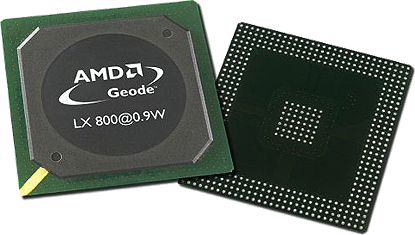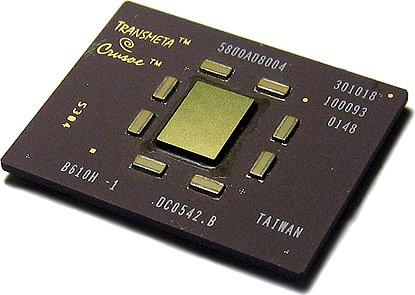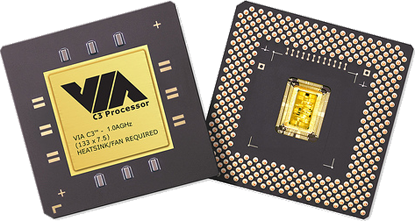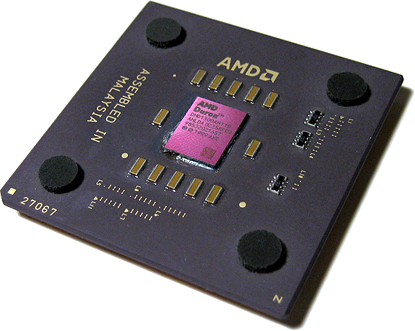A Brief History of CPUs: 31 Awesome Years of x86
National Semiconductor Geode
An evolution of the Media GX processor, the Geode picked up where Cyrix left off, but not for long. In 2003, National Semiconductor sold its Geode business to AMD, who continued to tweak the system-on-a-chip processor. Earlier versions can be found in some OLPCs, however AMD's latest Geodes (Geode NX) are based on the company's Athlon XP Thoroughbred core and include 256KB of L2 cache. It can also operate at up to 1GHz with passive cooling.
As of this year, AMD has stopped working on the Geode line.

Date Released: 1999
Clockspeed: 166MHz - 1.4GHz
Did you know?
Transmeta Crusoe and Efficeon
A newcomer to the x86 chip market, Transmeta's Crusoe debuted in 2000 amid much hype. Crusoe was designed as an energy conscious, cool-running mobile part consuming anywhere from 1W to 3W during typical usage. At first built on a 180nm manufacturing process (and later 130nm), it owed much of its power savings to a software emulation layer. This, combined with the lack of emulation for SSE instructions, led Intel's Don MacDonald to say "You should check whether the Transmeta chip is 100 percent x86-compatible."
Over time Transmeta would revise its Crusoe chip, but the lack of comparable performance to Intel's and AMD's offerings combined with only negligible real-world energy management led to limited success for Transmeta's x86 CPU. So in 2004, Transmeta released a second x86 chip, the Efficeon. The new Efficeon microarchitecure was based on a 256-bit VLIW (Very Long Instruction Word) processor rather 128-bit like the Crusoe. Through Morphing Software, it also added much better x86 software compatibility, including MMX, SSE, and SSE instructions.
All told, Efficeon offered significant performance gains over Crusoe, sometimes as high as 200 percent, but faced increasing competition from Intel and AMD in the mobile market. After losing hundreds of millions of dollars over several years, Transmeta stopped making chips and instead focused on selling its technology. In January 2009, Transmeta was acquired by Novafora.

(Image Credit: x86-guide.com)
Keep up to date with the most important stories and the best deals, as picked by the PC Gamer team.
Date Released: 2000
Clockspeed: 300MHz - 2GHz
Did you know?
VIA Cyrix III and C3
Cyrix once again passed hands, this time having been sold to VIA in 1999 who then released the Cyrix III x86 CPU in early 2000 for Socket 370 motherboards. Cyrix had already been working on the Cyrix III, but several design issues led to VIA issuing a core revision reducing the number of transistors from 22 million to 11 million. By doing so, the Cyrix III was primed to reach higher clockspeeds, which would come to label the chip in place the Performance Rating Cyrix had previously been using.
Yet another revision, codenamed Samuel 2, would add 64KB of L2 cache to the chip and switch from a 180nm to 150nm manufacturing process, again paving the way for faster clockspeeds. VIA would also later change the name of the Cyrix III to simply C3, as Cyrix technology was no longer part of the architecture.

Date Released: 2000
Clockspeed: 350MHz - 1.4GHz
Did you know?
AMD Duron
Making a bid for the performance crown is only half the battle, and so in 2000 AMD released its Duron processor to compete with Intel's Celeron and win over the budget market. Essentially a crippled Athlon Thunderbird, early Durons featured a slower frontside bus at 100MHz and, as is almost always the case with low-cost chips, reduced cache. Durons came with just 64KB of L2 cache at a time with 256KB and 512KB were becoming the norm. These ranged in frequency from 600MHz to 950MHz.
Second generation Durons would be based on the Athlon XP architecture and add SSE support, and a final Duron revision based on the Thoroughred Athlon XP would see a faster frontside bus (133MHz) and clockspeeds up to 1.8GHz.

(Image Credit: x86-guide.com)
Date Released: 2000
Clockspeed: 600MHz to 1.8GHz
Did you know?
Intel Pentium 4
Sometimes change is a good thing, and other times -- as is the case here -- change can turn out to be bad. But even worse is when everybody knows something is bad, yet nothing is done about it for a long, long time. Enter the Pentium 4 processor and Intel's new NetBurst architecture.
At the risk of oversimplifying, Intel's Pentium III processor thrived on a highly efficient design that, had Intel continued to tweak, probably would never have allowed AMD to build as big of an enthusiast following as it has done. Instead, Intel left the door open for AMD by fixating on increasingly higher clockspeeds, a goal it planned to reach by introducing an exceedingly long-staged pipeline in the Pentium 4. While this paved the path for higher clockspeeds, a longer stage pipeline meant a bigger performance penalty when a set of instructions had to be thrown out and started over from scratch. Imagine putting almost all the pieces of a car together on an assembly line, only to find out towards the end that the windshield doesn't fit. But rather than ordering a new windshield, you have to scrap the entire car and all the work that went into it.
Pentium 4 wasn't all bad, though, and it did introduce both SSE2 and SSE3 instruction sets. Combined with HyperThreading, the Pentium 4 excelled with multimedia and content creation tasks, as well as code optimized for the new core. And with 3D graphics cards continuing to increase in power, a P4 chip provided a serviceable foundation for gaming rigs. Overclockers took a keen interest in the Northwood core released in 2002. With a capable motherboard and RAM, even beginning overclockers could set their sights on 1GHz overclocks using air cooling.
Still, for a Pentium 4 to really shine, it needed to ramp up clockspeeds to unprecedented levels. Intel envisioned this happening with the much anticipated Prescott core, the first chip to be built on a 90nm manufacturing process. But Prescott ran uncomfortably hot at launch, offered negligible performance gains, failed to live up to its pre-release hype, and was getting trounched by AMD silicon in gaming benchmarks.

(Image Credit: windowsdevcenter.com)
Date Released : 2000
Clockspeed: 1.40GHz - 3.8GHz

